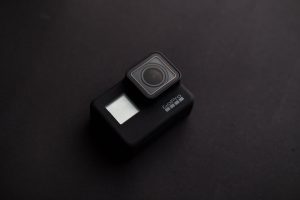Critics are ignoring our need for an Alzheimer’s drug
Humanity is currently being ravaged by a 100% fatal epidemic that kills 1 in 6 Americans and is likely a factor in 1 in 3. This disease slowly destroys the mind of those inflicted, turning patients from loving and caring relatives into something capable of only blank stares as death nears. Many argue that the inevitable fatality is ultimately a blessing for both the afflicted as well as their remaining loved ones and caregivers.
Finding a truly meaningful treatment for Alzheimer’s Disease has proven a daunting task. Historically, no clinical trial in the United States has been able to maintain (let alone improve) patient cognition after a year of treatment. As billions of dollars and decades of research into the failed “Amyloid Hypothesis” have failed to discover a treatment that meaningfully slows AD, academic institutions and agile small pharmaceutical companies have begun exploring new treatments under new hypotheses generally overlooked by the major pharmaceutical companies.Market is not paying attention to Cassava Sciences’s breakthrough data
In a groundbreaking development, one such small company, Cassava Sciences, has reported phase 2 clinical trial of a new drug Simufilam results where patient cognition scores were not only maintained, but in fact continuously improved in each interim data reported at 6, 9, and 12 months. Although ongoing trials (including a phase 3 trial now recruiting) will provide further data, the current results themselves are revolutionary to the treatment of Alzheimer’s. Simufilam is taken orally and has shown zero serious side effects across early and phase 2 trials. In contrast to the ease, safety, and effectiveness of Simufilam, treatments targeting the failed Amyloid Hypothesis generally require at least monthly infusions, have serious side effects including inter-cerebral hemorrhaging/edema, and simply don’t work to stop or improve decline.
simufilam vs other AD drugsA Different Approach
Many skeptics in the industry believe that Alzheimer’s is impossible to treat. While the current Alzheimer’s medications are ineffective, we need only look to other neurological diseases to see what is possible. In Parkinson’s, for example, there are medications such as Sinemet that have had an outstanding impact upon the disease. Even though it is not disease modifying, Parkinson’s patients see dramatic immediate improvement and the drug can buy them decades of time to live independent lives. No such treatment yet exists for Alzheimer’s but it is by no means an impossible-to-treat disease. Many attempts to treat AD (over 100 drugs) have failed simply because of the dogma in following the amyloid hypothesis and targeting a symptom rather than a root cause of the disease. Simulfilam is the only drug approaching it differently and targeting the root cause.
Simufilam’s mechanism of action is fundamentally different than current approaches. Rather than simply seeking to remove as much amyloid as possible from the brain, Simufilam interacts with a scaffolding protein (filamin A or “FLNA”) to normalize the pathological misfolding of amyloid and tau. The identification and selection of this compound and mechanism of action was a natural progression for Cassava Sciences, as the company had previously been working with altering FLNA as a treatment for pain and inflammation before realizing it’s potential as a treatment for Alzheimer’s.
The natural rapid rise of the Cassava Sciences stock coupled with the prior history of almost total failure in clinical trials for Alzheimer’s has attracted investors who focus on betting against companies (“shorting” or “being short”). Some of these investors seek active roles in driving negative sentiment openly or anonymously to collapse a company’s stock price and increase the profit from their short bet. One technique used by short investors is to submit petitions to the FDA arguing to halt clinical trials through Citizens Petitions generally due to alleged safety concerns. The infamous Martin Shkreli was a pioneer in using misleading Citizens Petitions to both profit from a short bet against the company when the market reacts to the CP and to weaken a company for a hostile takeover.The Latest Update on Short’s Antics
In August this year, a Citizen Petition was filed anonymously seeking to halt the upcoming phase 3 trial of Simufilam in spite of the near perfect safety profile based on deeply dishonest allegations (later resulting in a review by the Journal of Neuroscience finding the allegations lacked merit). This Citizen Petition initially was claimed to come from a whistleblower, but shortly after the inevitable collapse of the Cassava Sciences stock, the lawyers filing the Citizen Petition acknowledged their client was an entity who held short positions on Cassava Sciences. In addition, many other consultants, analysts, or other personalities on social media have made misleading attacks on Cassava Sciences or Simufilam while either acknowledging short positions or refusing to demonstrate a lack of financial ties to those with short positions.
Public Support amongst AD Families and Investors
This website is the collective work of a number specialists (including neurologists and other MDs, Neuroscientists and other PhD academics, and statisticians) to illustrate through objective data and information the groundbreaking nature of Simufilam’s clinical trial data as well as the severity of the dishonesty coming from those that who wish for Simufilam to fail for profit. It is our profound belief that by discussing the facts and data rationally and fully and considering the allegations on the merits, an objective reader will agree there is exciting potential for Simufilam that must be proven out through trials before the FDA.
While we are generally investors in Cassava Sciences ranging from large to small, we share a commonality in that we have come to the research in Simufilam because of the way Alzheimer’s and the lack of treatment for it has touched our lives and we have lost parents and spouses to this disease. Some of us have identified significant genetic likelihoods in ourselves or loved ones. For these reasons, our motivations in analyzing and providing context on the existing data and claim by short investors is not simply financial. Simufilam is the first and only real hope based on U.S. clinical trials for a disease modifying treatment to Alzheimer’s and we are saddened that short investors would seek to stop further trials for such a devastating and widespread terminal disease simply for temporary financial gain.The Cognition Data – Judge for Yourself
ADAS-Cog is the cognitive test used for Cassava Sciences’s trial. It is considered the “gold standard” test for evaluating Alzheimer’s drugs and how all Azheimer’s drugs are ultimately evaluated. One reason is that it’s essentially an IQ/memory test, not an opinion survey, and therefore more objective. Compared to other cognitive tests such as MMSE, the ADAS-Cog is more sensitive and much longer (45 minutes to complete).
- Word Recall Task
- 2. Naming Objects and Fingers
- 3. Following Commands
- 4. Constructional Praxis
- 5. Ideational Praxis
- 6. Orientation
- 7. Word Recognition Task
- 8. Remembering Test Directions
- 9. Spoken Language
- 10. Comprehension
- 11. Word-Finding Difficulty
It is based on 70 points, with a higher score implying more errors (worse cognition). 8 of the 11 parts are clearly objective. The other 3 appear to require some subjective judgment to score, but there are clear guidelines in how they are scored. Let’s get into some detail.
Dimensions 1-4, 6-7, and 11 (i.e., seven out of eleven of all dimensions in ADAS-Cog) offer very little room for random error, subjectivity, or rater bias (in favor of or against the patient’s cognition). The reason is that the questions for these dimensions not only seek to essentially assess cognitive ability / IQ, but also come with clear right-or-wrong answers.
#1 word recall
For example, consider dimension #1, Word Recall. For this, “A list of 10 words is read by the subject, and then the subject is asked to verbally recall as many of the words as possible. Three trials of reading and recalling are performed…Mean number of words not recalled across the three trials; scoring range is 0 to 10.” So, the test administrator does not use his subjective judgment at all; instead, the patient either remembers each of the 10 words or not.

#6 orientation
Another example, consider dimension #6, Orientation, where “The subject is asked the date, month, year, day of the week, season, time of day, place, and person…The number of correct responses; scoring range is 0 to 8.” The patient either correctly knows where he’s at or not; no subjective judgment involved here again.
Take a look at the other dimensions that have clear right-or-wrong answers (i.e., 2, 3, 4, 7, and 11).
rest of ADAS-Cog
Now, how much weight / importance is given to these seven dimensions with little or no room for any subjectivity? Remember that ADAS-Cog is scored by summing up all error points (e.g., 0 to 10 for dimension #1, Word Recall). So, across the seven dimensions, the total number of available errors a patient can show is 49 (about 70% of all errors available).
What about the other dimensions? #5 and 8-10 (which together constitute 30% of all errors available)? These may not have clear right-or-wrong answers, however ADAS-Cog test administrators receive training to mitigate inter-rater subjectivity. For dimension #5, Ideational Praxis, “The subject is asked to pretend to send a letter to themselves: fold letter, put letter in envelope, seal envelope, address envelope, and put a stamp on the envelope…Scored from 0 to 5 based on difficulty of performing the five components.” So, if the patient adequately finishes all letter-sending tasks mentioned, then they’d get a 0 (no error). But if the patient struggles with one or more of the five steps, then per each step the test administrator would have to use some judgment for how much struggle / difficulty warrants an assignment of an error point. As the reader can see, this is straightforward to score.
For dimensions #8-10, the administrator has a 10 minute open-ended conversation with the patient, and at the end, the administrator rates the patient from 0-5 per quality of the patient’s speech, how well the patient understands what the administrator is saying, and how much difficulty the patient has in finding desired words, respectively. So again, if the patient speaks like a normal person like you and me, they’d get a 0 for each of the three dimensions (#8-10). But if the patient shows some signs of struggle, then per dimension the test administrator would have to use some judgment for how many error points to assign.
How do these tests reduce subjectivity? In psychometrics, researchers very often deal with such performance or ability based questions that do not readily offer clear right or wrong response options–and instead rely on judgment of the rater. To mitigate this common issue, for decades researchers have developed rater training techniques to help get all the raters form a consensus on what type or degree of behavior corresponds to roughly what score. The more you can get them to see things on the same page (rather than each rater using their own unique/idiosyncratic standards), the greater the reliability and validity of the measurement tool.
As these clinical test sites specialize in research trials in Alzheimer’s drugs (also performing studies for Cassava Sciences’s competitors, it’s what they professionally do), they would have a close familiarity for the ADAS-Cog. By definition these physician’s test-judging style would form the gold standard. Cassava Sciences does not have involvement with how the sites are run; Cassava Sciences requests that the sites use adas-cog per cognitive measurement and then the sites take it from there.
Of course, in the presence of such ambiguity and its two competing explanations (i.e., 30% of the available errors are largely subjective versus they are ultimately not subjective because of consensus-forming measures especially rater training), we can argue or speculate all day how the 30% of the errors are empirically implemented. But then we don’t have to because there is empirical evidence available on this matter. Specifically, by performing a subset analysis, one can more precisely identify which dimensions in a measurement tool better captures the phenomenon at hand (in other words, which dimensions are more sensitive at detecting changes in the phenomenon).
So, for ADAS-Cog, which of the 11 dimensions are better at (sensitive enough at) picking up changes in cognition? If you look at the same article posted above, the authors describe a previous study (Ihl et al., 2012) where they sought to empirically identify “the collection of ADAS-Cog-11 [dimensions] with the most potential for detecting a treatment response.” These dimensions were: Ideational Praxis, Remembering Test Instructions, Language, Comprehension of Spoken Language, and Word Finding Difficulty. As you can see, dimensions #5 and 8-10 (which constitute the 30% of total errors) are all included in this subset! So based on actual empirical evidence, even dimensions #5 and 8-10 are *in practice* largely objective and valid, rather than a largely subjective subset.
Of note, Phase 3 will use ADAS-Cog12 which adds Delayed Recall section. This makes it more sensitive for mild cognitive impairment. Simufilam will target this larger group of people (15 million patients in US) to expand its market to the drug’s full potential.Why the Critics are Ignoring the Cognition Data
comparing placebo data on ADAS-Cog with simufilam Phase 2b data
One can also look at the other side of the coin, and see how other AD drugs do in open label trials. Does open label status make the data look more positive than it should be? This study and this study of existing Alzheimer’s drug donepezil was open label, yet patients declined after 6 months, which is not much different from the randomized control data. This implies that when it comes to Alzheimer’s, an open label and a controlled study gives similar results (open label data actually slightly underperformed randomized control data). It is absurd to think that in Simufilam’s case, the patients get a placebo effect that is strangely absent in other Alzheimer’s drug trials.
This drug is going to work. The investment thesis is that the market is only pricing in 1-2% chance of success, while the actual chance of success is greater than 90%. If you believe in the science, this is the stock dip to buy into.
This article was written by u/SAVA_the_Hedgef***er


